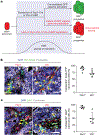Upholding a role for EMT in breast cancer metastasis
- PMID: 28682326
- PMCID: PMC6283276
- DOI: 10.1038/nature22816
Upholding a role for EMT in breast cancer metastasis
Conflict of interest statement
Competing Financial Interests R.A.W. is listed as an inventor on three patent applications filed by the Whitehead Institute for Biomedical Research relating to the formation of cancer stem cells through activation of an EMT program. US patent application number US 14/441,697 describes a method to use PKCα/FRA1 pathway inhibitors to target carcinoma cells that are identified by their increased expression of EMT-related genes. US patent application number US 15/307,657 describes a method to induce cancer stem cells to undergo EMT rendering them amenable to conventional treatments. US patent application number US 14/065,311 describes methods for identifying compounds and compositions that target cancer stem cells, including cancer stem cells that have undergone EMT R.A.W. is also listed as an inventor on two related patents that have been granted. US patent number US9212347 describes methods for preparing progenitor cells by inducing EMT. US patent number US9308238 describes methods and compounds for modulating and inducing EMT. R.A.W. is also a cofounder of Verastem Inc.
Figures


References
Grants and funding
LinkOut - more resources
Full Text Sources
Other Literature Sources

